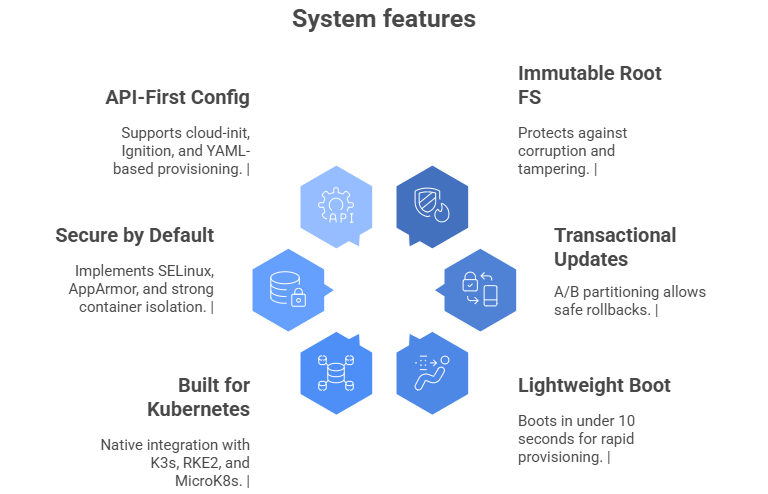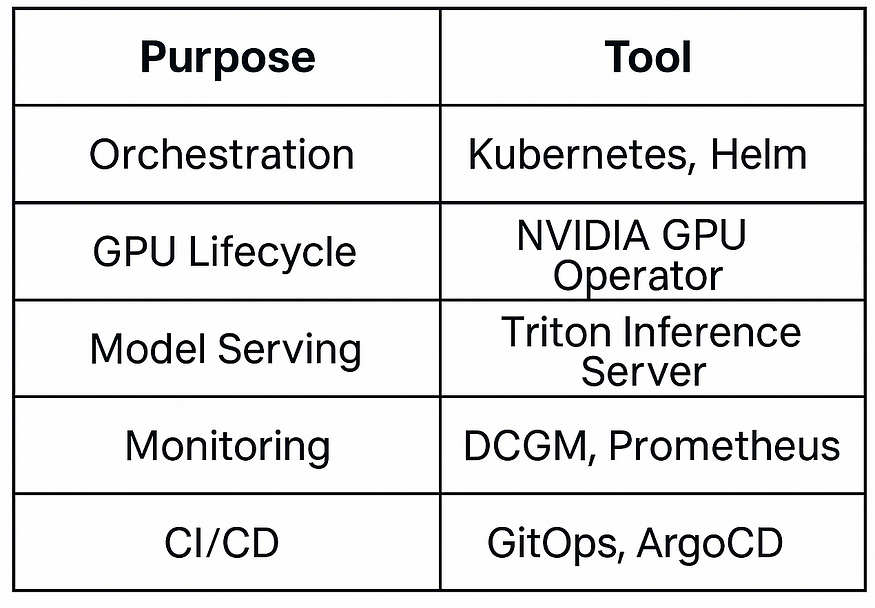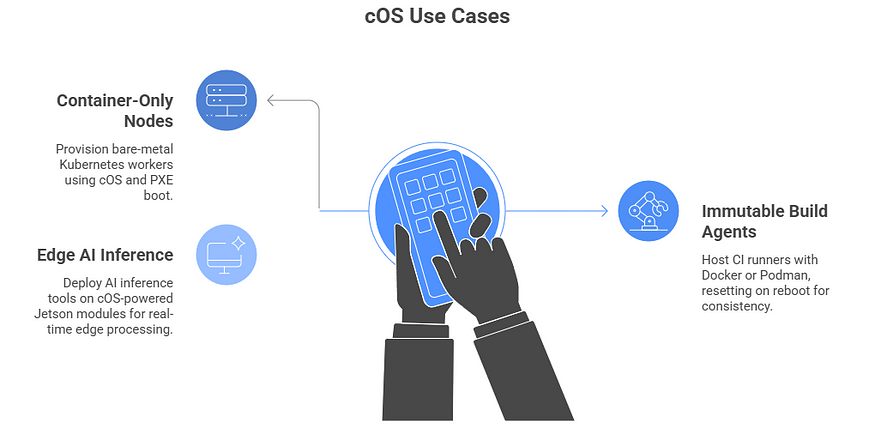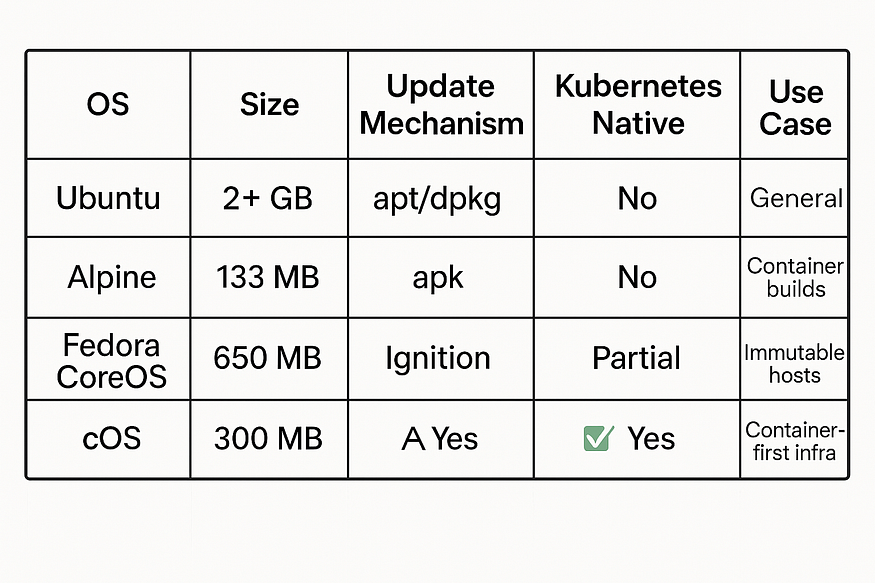cOS (Container OS): Why cOS Is the Minimalist OS Every Container-First Data Center Needs
 Anuja Sawant
Anuja SawantTable of contents
- What is cOS?
- Technical Features of cOS
- Why Traditional OSes Don’t Work for Containers
- Installing cOS: Developer Guide
- DevOps Integration with Kubernetes
- Infrastructure as Code with Terraform
- cOS in Edge Data Centers
- Security Benefits of cOS
- Performance & Resource Optimization
- Real-World Use Cases
- Atomic Updates & Rollback
- How cOS Compares to Other OSes
- Tools That Work Seamlessly with cOS
- Conclusion
In the age of Kubernetes and DevOps, data centers are rapidly moving away from traditional monolithic operating systems. Today, the goal is speed, efficiency, and immutability, not bloated packages and legacy compatibility. That’s where cOS (Container OS) enters the picture.
cOS is a minimalist Linux-based operating system purpose-built for container-native infrastructure. Designed to be immutable, atomic, and cloud-agnostic, cOS strips away unnecessary components and presents a secure, efficient runtime for Kubernetes, Docker, and OCI-compliant containers.
This blog takes a deep dive into how cOS works, what makes it unique, and why it’s becoming an essential OS for container-first data centers — especially when paired with modern orchestration tools like Kubernetes, Nomad, and K3s.
What is cOS?
cOS (Container Operating System) is:
A minimal Linux OS, typically under 300 MB
Built with read-only root filesystem
Supports OTA (Over-the-Air) atomic upgrades
Based on openSUSE, Alpine, or Ubuntu Core, depending on the distribution
Designed to boot fast, update fast, and recover fast
It’s not a general-purpose OS. There’s no package manager like apt or yum—you deploy containers, and that’s it.
Technical Features of cOS
Let’s break down the technical characteristics that make cOS stand out:
Immutable Root FS: Protects against corruption and tampering
Transactional Updates: A/B partitioning allows safe rollbacks
Lightweight Boot: Boots in under 10 seconds for rapid provisioning
Built for Kubernetes: Native integration with K3s, RKE2, and MicroK8s
Secure by Default: Implements SELinux, AppArmor, and strong container isolation
API-First Config: Supports cloud-init, Ignition, and YAML-based provisioning

Why Traditional OSes Don’t Work for Containers
Most legacy OSes are built with:
Kernel modules and packages you’ll never use
System services designed for monolithic apps
Slow and complex update mechanisms
Mutable states that are prone to corruption
In contrast, cOS is built solely to run containers, with none of the extra baggage.
Installing cOS: Developer Guide
A typical cOS install takes under 5 minutes. Here’s a simplified flow for bare metal or VM deployment:
Step 1: Flash cOS ISO
dd if=cos.iso of=/dev/sdX bs=4M status=progress
Step 2: Boot into cOS Live
On boot, it presents a cloud-init like screen to configure network and cluster settings.
Step 3: Use system installer
cos-installer --device /dev/sda --config ./cloud-config.yaml
Sample cloud-config.yaml
hostname: node-1
users:
- name: cosadmin
passwd: $6$rounds=4096$RANDOM
sudo: ['ALL=(ALL) NOPASSWD:ALL']
install:
bundles:
- k3s
reboot: true
DevOps Integration with Kubernetes
cOS integrates deeply with lightweight Kubernetes distros such as:
K3s from Rancher (ideal for edge and IoT)
RKE2 for production-grade K8s clusters
MicroK8s from Canonical
Example: Bootstrapping K3s
curl -sfL https://get.k3s.io | sh -
systemctl enable k3s
This simplicity makes it easy to deploy container clusters on bare metal, cloud VMs, or edge devices.
Infrastructure as Code with Terraform
You can automate cOS provisioning using Terraform and cloud-init compatible providers.
Example: Terraform snippet for cOS on AWS
resource "aws_instance" "cos_node" {
ami = "ami-xxxxxxxx"
instance_type = "t3.micro"
user_data = file("cloud-config.yaml")
tags = {
Name = "cOS_Node"
}
}
Combine this with tools like Packer, Pulumi, or Crossplane for complete GitOps-driven deployments.
cOS in Edge Data Centers
One of cOS’s biggest strengths is in edge computing. Why?
Fast boot time = less downtime at remote locations
Immutable OS = no drift, no surprises
Remote management = OTA updates and YAML-driven configs
You can deploy a 3-node Kubernetes cluster on Raspberry Pi or Jetson Nano using cOS + K3s in under 10 minutes.
Security Benefits of cOS
Security is a key concern in container-native environments. Here’s how cOS helps:

Because there’s no general-purpose access, even accidental misconfigurations are less likely.
Performance & Resource Optimization
cOS uses a custom-compiled kernel with only container-required modules:
Lower boot times
Better memory utilization
Less overhead on low-end hardware
This makes it suitable for:
AI inference nodes (Jetson + cOS)
CI/CD runners (GitLab on cOS)
CDN or DNS edge servers
Real-World Use Cases
1. Container-Only Kubernetes Nodes
Provision hundreds of bare-metal Kubernetes workers using cOS and PXE boot.
2. Immutable Build Agents
Use cOS to host CI runners with Docker or Podman. They reset on reboot, ensuring consistency.
3. Edge AI Inference
Deploy TensorRT, Triton Server, or YOLOv8 in containers on cOS-powered Jetson modules for real-time inference at the edge.

Atomic Updates & Rollback
Inspired by CoreOS, cOS supports A/B partition-based updates.
sudo cos-upgrade --source https://example.com/cos-latest.img
If the new update fails, it reverts to the older one automatically. No need to manually rollback.
How cOS Compares to Other OSes

Tools That Work Seamlessly with cOS
K3s, RKE2, MicroK8s — Lightweight Kubernetes
Podman, Docker, Containerd
Ignition, cloud-init, Terraform
Flux, ArgoCD — GitOps agents
Grafana, Prometheus — Lightweight monitoring
Conclusion
In a world where containers dominate application delivery, traditional operating systems fall short. cOS is the future of OS design — lean, secure, and built purely to support Kubernetes-native workloads.
With immutable architecture, container-centric design, and DevOps-friendly deployment, cOS is ideal for data centers, CI/CD systems, and edge infrastructure.
Subscribe to my newsletter
Read articles from Anuja Sawant directly inside your inbox. Subscribe to the newsletter, and don't miss out.
Written by
